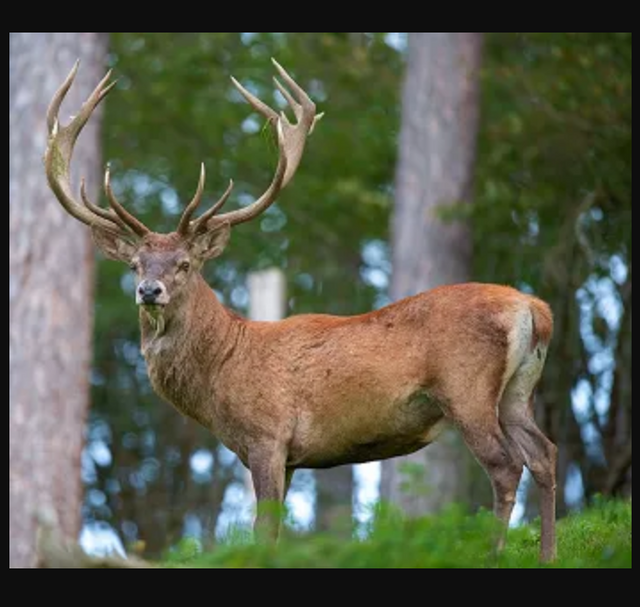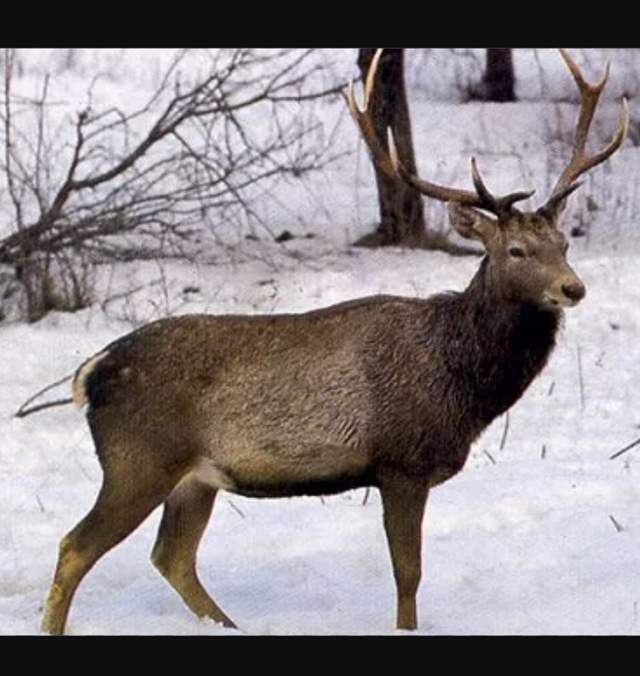Kashmir stag (Cervus elaphus hanglu) complete detail

Kashmir stag (Cervus elaphus hanglu) complete detail – updated. Description of Kashmir stag (Cervus elaphus hanglu). Classification of Kashmir stag (Cervus elaphus hanglu). Habit and habitat of Kashmir stag (Cervus elaphus hanglu). They prefers to live in dense riverside forests between 1700 and 3600 meters of high valleys, and also in the mountain areas.
Kashmir stag is a herbivores animal, they feeds on flowers, leaves, and tender shoots of shrubs. The weight of male Kashmir stag is between 150 to 250 kg., and weight of female is between 100 to 160 kg. Head to body length measures about 180 to 220 cm. Sides and limbs are paler. Belly in males is dark brown in color. Tail is relatively short in size.
The white rump patch does not extend much above the tail and is divided by a broad median stripe extending down to the base of the tail and sometimes to its extremity. The hair at the lower neck is long and shaggy with varying colors like brown or brownish ash or dark liver. Belly in males are dark brown in color. The beam is strongly curved inward, while the brow and bez tines are usually close together and above the burr. The fawns have distinct spots during the first few weeks of their lives………..
In males, hairs on the ridge of the neck are long, thick and bushy. Age of sexual maturity is 2 to 3 years for male and 1 to 3 years for female. Breeding season is between September to October. A stag will pursue a receptive female through the forest and uphill slopes till mating takes place. Normally one offspring per female.
Distinctive Identification:
Kashmir stag is a Schedule – I animal, according to wildlife (Protection) act, 1972 and classified as Endangered (EN) by the IUCN.
The weight of male Kashmir stag is between 150 to 250 kg., and weight of female is between 100 to 160 kg. Head to body length measures about 180 to 220 cm. They are about 100 to 135 cm high at the shoulder.
Color of body ranges from light to dark brown, fading to dingy white on the lips, chin, underparts, and buttocks. . The inner sides of the buttocks are grayish white, followed by a line on the inner sides of the thighs and black on the upper side of the tail.
In summer, their fur looks brighter rather than during other seasons. The color fades during the summer but tones up with the denser winter coat, which in a big stag is a very dark or rufous brown.
Sides and limbs are paler. Belly in males is dark brown in color. Tail is relatively short in size. The white rump patch does not extend much above the tail and is divided by a broad median stripe extending down to the base of the tail and sometimes to its extremity.
In males, hairs on the ridge of the neck are long, thick and bushy. The hair at the lower neck is long and shaggy with varying colors like brown or brownish ash or dark liver. Belly in males are dark brown in color.
The beam is strongly curved inward, while the brow and bez tines are usually close together and above the burr.
The fawns have distinct spots during the first few weeks of their lives after which these fade away rapidly. Normal head have five points on the on each antler.

Classification
Common Name – Kashmir stag
Local Name – Hangul / Red deer
Zoological Name – Cervus elaphus hanglu
Kingdom – Animalia
Phylum – Chordata
Class – Mammalia
Order – Cetartiodactyla
Family – Cervidae
Genus – Cervus
Species – Cervus elaphus
Subspecies – Cervus elaphus hanglu
Conservational Status – Schedule – I, according to wildlife (Protection) act, 1972 and classified as Endangered (EN) by the IUCN.
Distribution:
In India, limited to the north side of the Valley of Kashmir and some of the adjacent valley.
They found Dachigam Sanctuary in Jammu and Kashmir, with some scattered population in other parts of the State and in Gamagal Sanctuary of Himachal Pradesh.
Habit and habitat:
They prefers to live in dense riverside forests between 1700 and 3600 meters of high valleys, and also in the mountain areas.
They spent winters in the lower levels, and summer on the heights. They found in dense riverine forests, high valleys, and mountains of the Kashmir valley and northern Chamba in Himachal Pradesh.
After shedding their antlers between March to April most stags go uphill and congregate about the snow line. Kashmir stag is a social animal. They lives in groups of two to 18 individuals, sometimes found single.
Kashmir stag is a herbivores animal, they feeds on flowers, leaves, and tender shoots of shrubs. They also feed on Lichens, Mosses, Ferns, and Mushrooms.
Age of sexual maturity is 2 to 3 years for male and 1 to 3 years for female. Breeding season is between September to October. About the end of September, new antlers have hardened. They commence to roar and challenge.
They join the hinds at the beginning of October, and as the rut develops, engage in conflict. A stag will pursue a receptive female through the forest and uphill slopes till mating takes place.
Normally one offspring per female. The gestation period is 7-8 months. After dropping their fawns, the hinds too leave the lowest part of the valley and move to the upper slopes where the best and most nutritious pastures are available, and will use these areas for raising their young till the weather turns harsh, forcing them down again. Average lifespan of Kashmir stag is 15 to 20 years.
Threats and conservation:
These deer once numbered from about 5,000 animals in the beginning of the 20th century. Unfortunately, they were threatened, due to habitat destruction, over-grazing by domestic livestock, and poaching. This dwindled to as low as 150 animals by 1970. However, the state of Jammu & Kashmir, along with the IUCN and the WWF prepared a project for the protection of these animals. It became known as Project Hangul. This brought great results and the population increased to over 340 by 1980.
Much of the earlier published material was by the distinguished E. P. Gee, a member of the Bombay Natural History Society. Shortly before the expedition was mounted, Fiona Guinness and Tim Clutton-Brock, both noted deer experts, had visited Kashmir and had gathered some useful field data, which confirmed that Hangul numbers were at a dangerously low level. The traditional breeding grounds of the hangul deer is upper danchigam,which is now occupied by Gujar shepherds and their dogs in summer(refer the book a life with wildlife by M.K.Ranjitsinh)
The animal is battling for its survival in its last bastion: they are now scattered within 141 km² of the Dachigam National Park located on foothills of Zabarwan range on the outskirts of Srinagar. Known for its magnificent antlers with 11 to 16 points, hangul was once distributed widely in the mountains of Kashmir. During the 1940s, their number was believed to be about 3,000-5,000. As per the census in 2008, only around 160 exist.In 2015,the Hangul population estimation exercise was conducted in which the count of Hanguls in and around their habitats in Kashmir valley is just 186.There are plans to breed them in captivity to increase their chances of survival.